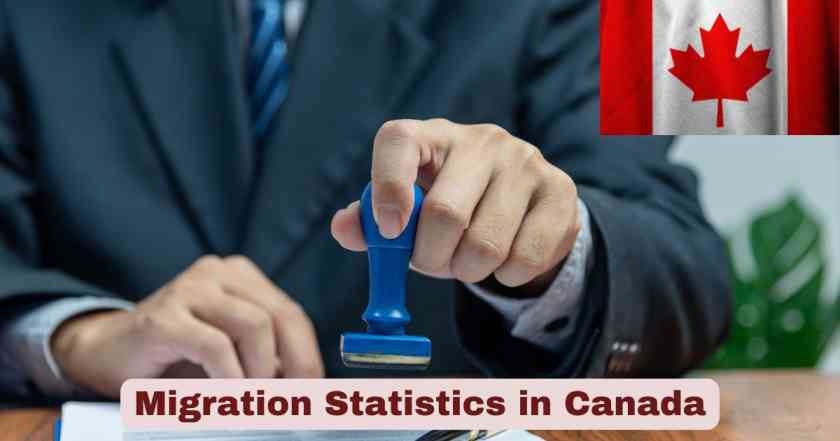Canada Migration in Canada 2025
In 2025, Canada finds itself at a pivotal moment in its migration policy evolution, navigating a complex intersection of economic necessity, infrastructure limitations, and shifting public opinion. After years of record-breaking population growth fueled primarily by immigration, the country has strategically pivoted toward a more controlled and sustainable approach. This shift comes in response to growing concerns about housing affordability, healthcare capacity, and educational infrastructure. The first quarter of 2025 marked the slowest population growth since the onset of COVID-19 in 2020, signaling a deliberate slowdown following the federal government’s decision to reduce immigration targets and place limits on temporary residents. The updated policy framework represents a fundamental rebalancing—one that seeks to align population growth with Canada’s ability to support new arrivals effectively and equitably.
Despite the slowdown, international migration remains the dominant driver of population growth in Canada, as natural increase continues to decline due to an aging population and low birth rates. The federal government has recalibrated its permanent resident target to 395,000 for 2025, down from the previously projected 500,000, and introduced new caps on international students and temporary workers. These policy changes aim to prioritize economic migrants and improve integration outcomes, particularly through Canada’s two-step immigration system, which favors those with existing Canadian experience. At the same time, regional disparities in migration flows—such as Alberta’s population boom and Ontario’s recent losses—highlight the dynamic nature of interprovincial shifts driven by employment prospects and cost of living. Together, these trends underscore a new era in Canadian migration: one focused on quality over quantity, sustainability over speed, and long-term resilience over short-term expansion.
Migration Statistics & Facts in Canada 2025
| Migration Indicator | 2025 Value | Previous Period | Change |
|---|---|---|---|
| Total Population (April 1, 2025) | 41,548,787 | 41,528,680 (Jan 1) | +20,107 |
| Quarterly Population Growth | 0.0% | 0.4% (Q3 2024) | -0.4% |
| Non-Permanent Residents | 2,959,825 | 3,020,936 (Jan 1) | -61,111 |
| Q1 2025 Immigration Admissions | 104,256 | 129,120 (Q1 2024) | -24,864 |
| 2025 Immigration Target | 395,000 | 500,000 (original) | -105,000 |
| Temporary Residents as % of Population | 7.1% | 7.4% (Oct 2024) | -0.3% |
| Study Permit Holders Decrease | -53,669 | N/A | Largest Q1 Drop |
| Work Permit Holders | 1,453,481 | 1,458,595 (Jan 1) | -5,114 |
| Asylum Claimants Record High | 470,029 | 457,285 (Jan 1) | +12,744 |
| Interprovincial Migrants (Q1) | 81,231 | 91,234 (Q1 2024) | -10,003 |
The migration data for 2025 reveals a pivotal transformation in Canada’s population dynamics. After several years of record-breaking increases, the total population growth has plateaued, with a minimal increase of only +20,107 individuals in Q1 2025. This represents a 0.0% quarterly growth rate, marking the slowest expansion since the COVID-19 lockdown era of 2020. The significant drop is directly tied to the government’s revised immigration strategy, which saw the national immigration target cut by over 100,000, from an original 500,000 to 395,000 for 2025. One of the clearest indicators of this shift is the substantial decrease in non-permanent residents by 61,111, driven largely by a record decline of 53,669 study permit holders—the sharpest quarterly drop recorded. This suggests a deliberate recalibration of temporary migration streams to reduce pressure on housing, healthcare, and education systems, particularly in provinces like Ontario and British Columbia, which have historically hosted the largest share of international students.
Simultaneously, the data shows a complex interplay between controlled reductions and persistent growth in certain categories. While work permit holders only saw a modest decline of 5,114, indicating stability in Canada’s reliance on foreign labor, asylum claimants surged to a record high of 470,029, rising by nearly 13,000 in just three months. This contrast reflects global instability and continued demand for Canadian protection pathways, even as other migration streams are curtailed. Additionally, interprovincial migration dropped by 10,003, further reinforcing the national trend of reduced population fluidity. These numbers underscore the evolving priorities of Canada’s immigration framework in 2025—shifting focus from rapid population growth to managed, sustainable migration, with a particular emphasis on long-term integration and economic contribution.
International Immigration Trends in Canada 2025
| Immigration Category | 2025 Target | 2024 Target | Percentage Change |
|---|---|---|---|
| Total Permanent Residents | 395,000 | 485,000 | -18.6% |
| Economic Class | 281,135 | 339,750 | -17.2% |
| Family Class | 84,000 | 114,000 | -26.3% |
| Protected Persons/Refugees | 25,800 | 76,300 | -66.2% |
| Humanitarian/Other | 4,065 | 8,000 | -49.2% |
| French-Speaking Target | 8.5% | 6.0% | +2.5% |
| In-Canada Transitions | 40%+ | 35% | +5% |
| 2026 Target | 380,000 | N/A | New Target |
| 2027 Target | 365,000 | N/A | New Target |
Canada’s international immigration strategy for 2025 demonstrates a clear shift toward sustainable growth and enhanced integration outcomes. The government has reduced immigration targets from 500,000 permanent residents to 395,000 in 2025, further decreasing to 380,000 in 2026 and setting a target of 365,000 permanent residents in 2027. This represents a significant recalibration from the ambitious growth targets set in previous years.
The most dramatic reduction occurred in the Protected Persons and Refugees category, which saw a 66.2% decrease from 76,300 to 25,800 admissions. This reflects Canada’s response to processing backlogs and the need to manage refugee intake more effectively. Meanwhile, the Economic Class category, while reduced by 17.2%, continues to represent the largest portion of immigration admissions, emphasizing Canada’s priority on skilled workers who can contribute immediately to the economy. More than 40% of anticipated permanent resident admissions in 2025 will be from those who are already in Canada as temporary residents, highlighting the effectiveness of Canada’s two-step immigration process.
Top 10 Source Countries for Canadian Immigration (2024)
| Rank | Country | New Permanent Residents |
|---|---|---|
| 1 | India | 64,730 |
| 2 | Philippines | 14,360 |
| 3 | China | 13,100 |
| 4 | Nigeria | 8,625 |
| 5 | Afghanistan | 7,055 |
| 6 | Cameroon | 6,785 |
| 7 | Iran | 5,860 |
| 8 | Pakistan | 4,485 |
| 9 | United States | 4,180 |
| 10 | France | 4,040 |
India remains by far the largest source of new permanent residents to Canada, accounting for more than 64,000 new PRs in the first five months of 2024. This represents approximately 31% of all new immigrants during this period. Despite maintaining its lead, there has been a noticeable year-over-year decline in Indian immigration, likely influenced by evolving diplomatic tensions and Canada’s recent caps on temporary immigration. The Philippines and China continue to rank second and third, maintaining their long-standing positions as top contributors to Canada’s immigrant population. These trends reflect Canada’s continued reliance on large Asian economies to sustain its labor market and demographic growth.
Notably, African countries are gaining a stronger foothold in Canada’s immigration landscape. Nigeria and Cameroon occupy the fourth and sixth spots respectively, signaling increasing diversity in migration inflows. Afghanistan ranks fifth, driven predominantly by humanitarian and refugee resettlement efforts. Meanwhile, Iran, Pakistan, the U.S., and France round out the top 10, reflecting a mix of economic migration, family reunification, and cultural exchange. The presence of both traditional partners like the U.S. and newer, fast-growing sources like Cameroon illustrates Canada’s broad and evolving immigration profile that balances economic priorities with humanitarian obligations.
Regional Migration Patterns in Canada 2025
| Province/Territory | Population (April 1, 2025) | Quarterly Change | Net Interprovincial Migration |
|---|---|---|---|
| Alberta | 4,980,659 | +0.4% | +7,176 |
| Ontario | 16,176,977 | -0.0% | -5,664 |
| British Columbia | 5,719,961 | -0.0% | -2,357 |
| Quebec | 9,110,616 | -0.0% | -1,013 |
| Prince Edward Island | 180,029 | +0.4% | +749 |
| Manitoba | 1,507,330 | +0.2% | +106 |
| Saskatchewan | 1,253,569 | +0.2% | -152 |
| Nova Scotia | 1,080,418 | +0.1% | -49 |
| New Brunswick | 859,839 | +0.1% | N/A |
| Newfoundland and Labrador | 545,464 | -0.0% | -115 |
Regional migration patterns in 2025 reveal significant shifts in Canada’s internal population dynamics. Alberta continues to be the primary beneficiary of interprovincial migration, recording its 11th consecutive quarter of net population gains with 7,176 new residents from other provinces and territories. This sustained trend reflects Alberta’s robust economic opportunities, particularly in the energy sector and technology industries, combined with relatively lower living costs compared to other major Canadian centers.
The most striking development is the population decline in Canada’s largest provinces. Ontario experienced its largest quarterly population loss since comparable records began in 1951, with 5,664 fewer residents, while British Columbia also recorded its most significant quarterly decline with 2,357 fewer residents. These declines primarily result from reduced numbers of non-permanent residents, particularly international students, rather than interprovincial migration patterns. The largest decrease in non-permanent residents in the first quarter of 2025 came from people holding only a study permit (-53,669). Most of this decline occurred in Ontario (-30,160) and British Columbia (-11,742).
Temporary Foreign Workers and International Students in Canada 2025
| Temporary Resident Category | Numbers (April 1, 2025) | Quarterly Change | Policy Impact |
|---|---|---|---|
| Total Non-Permanent Residents | 2,959,825 | -61,111 | Largest decrease since COVID-19 |
| Work Permit Holders | 1,453,481 | -5,114 | Stable priority category |
| Study Permit Holders | N/A | -53,669 | Largest reduction |
| Asylum Claimants/Protected Persons | 470,029 | +12,744 | Record high level |
| Percentage of Total Population | 7.1% | -0.3% | Moving toward 5% target |
| Target for 2027 | 5.0% | -2.1% | Government objective |
| Two-Step Immigration Success | 38% | +14% | Above median earnings |
The management of temporary foreign workers and international students represents one of the most significant policy shifts in Canada’s immigration approach for 2025. The number of temporary residents in Canada fell by 61,111 from January 1, 2025 to April 1, 2025, marking the government’s success in implementing more restrictive temporary resident policies while maintaining economic priorities.
In 2022, among former temporary foreign workers who became economic immigrants, 38% had pre-immigration Canadian earnings above the national median earnings, up from 24% in 2000. This demonstrates the effectiveness of Canada’s two-step immigration system, where temporary residents gain Canadian experience before transitioning to permanent residence. The government’s strategy of maintaining work permit holders at stable levels while reducing student populations reflects a prioritization of economic contributors over pure population growth. Starting in 2025, Canada will have targets for temporary residents, including international students and temporary foreign workers, providing more predictable planning frameworks for both applicants and educational institutions.
Economic Migration and Labor Market Impact in Canada 2025
| Economic Indicator | 2025 Data | Previous Period | Impact Assessment |
|---|---|---|---|
| Economic Class Immigrants | 281,135 | 339,750 (2024) | Primary economic driver |
| Provincial Nominee Program | Major portion | N/A | Regional economic needs |
| Express Entry System | Continuing | N/A | Skilled worker selection |
| In-Canada Experience | 40%+ | 35% (2024) | Higher success rates |
| French-Speaking Target | 8.5% | 6.0% (2024) | Quebec/Franco support |
| Median Earnings Achievement | 38% | 24% (2000) | TFW success rate |
| Labor Market Integration | Improved | N/A | Two-step advantage |
Economic migration continues to form the cornerstone of Canada’s immigration strategy, even with reduced overall targets. The Economic Class category maintains its position as the largest immigration stream, accounting for approximately 71% of all permanent resident admissions in 2025. This emphasis reflects Canada’s continued focus on attracting skilled workers who can immediately contribute to the economy and fill critical labor shortages across various sectors.
The Provincial Nominee Program plays an increasingly important role in addressing specific regional economic needs, allowing provinces and territories to select immigrants based on local labor market demands. Over 40% of permanent resident admissions for 2025 are expected to be people who are already in Canada and contributing to our communities, highlighting the success of Canada’s two-step immigration system. This approach has proven particularly effective, with research showing that newcomers with Canadian experience demonstrate superior long-term economic outcomes compared to those immigrating directly from abroad.
Future Migration Projections & Policy Implications in Canada 2025
| Future Target | 2025 | 2026 | 2027 | Policy Direction |
|---|---|---|---|---|
| Permanent Residents | 395,000 | 380,000 | 365,000 | Gradual reduction |
| Temporary Residents % | 7.1% | 6.0% | 5.0% | Controlled decrease |
| French-Speaking Target | 8.5% | 9.5% | 10.0% | Francophone emphasis |
| In-Canada Transitions | 40%+ | 42%+ | 45%+ | Experience priority |
| Economic Class Focus | 71% | 73% | 75% | Skills-based selection |
| Population Growth Rate | 0.8% | 0.7% | 0.6% | Sustainable growth |
Canada’s migration policy trajectory through 2027 demonstrates a clear commitment to sustainable population growth while maintaining economic competitiveness. The three-year immigration levels plan represents a strategic shift from quantity to quality, with enhanced focus on successful integration outcomes and community capacity. Targets for permanent residents rose from 341,000 in 2019 to 437,000 in 2022, with a goal of admitting 500,000 annually by 2025. Amid mounting public pressure, however, the government backtracked and lowered targets in 2024.
The government’s approach balances multiple objectives: maintaining Canada’s reputation as a welcoming destination for immigrants while ensuring sustainable growth that doesn’t overwhelm housing markets, healthcare systems, and educational infrastructure. The emphasis on French-speaking immigrants, increasing from 8.5% in 2025 to 10% by 2027, reflects Canada’s commitment to supporting francophone communities outside Quebec and addressing demographic challenges in French-speaking regions. This strategic approach to migration management positions Canada to benefit from global talent while maintaining social cohesion and economic stability for the remainder of the decade.
Disclaimer: The data research report we present here is based on information found from various sources. We are not liable for any financial loss, errors, or damages of any kind that may result from the use of the information herein. We acknowledge that though we try to report accurately, we cannot verify the absolute facts of everything that has been represented.







